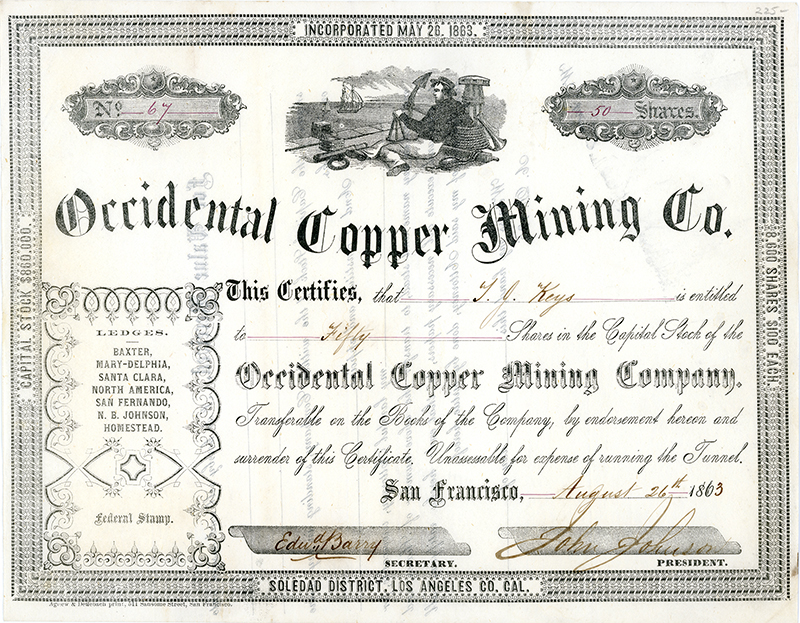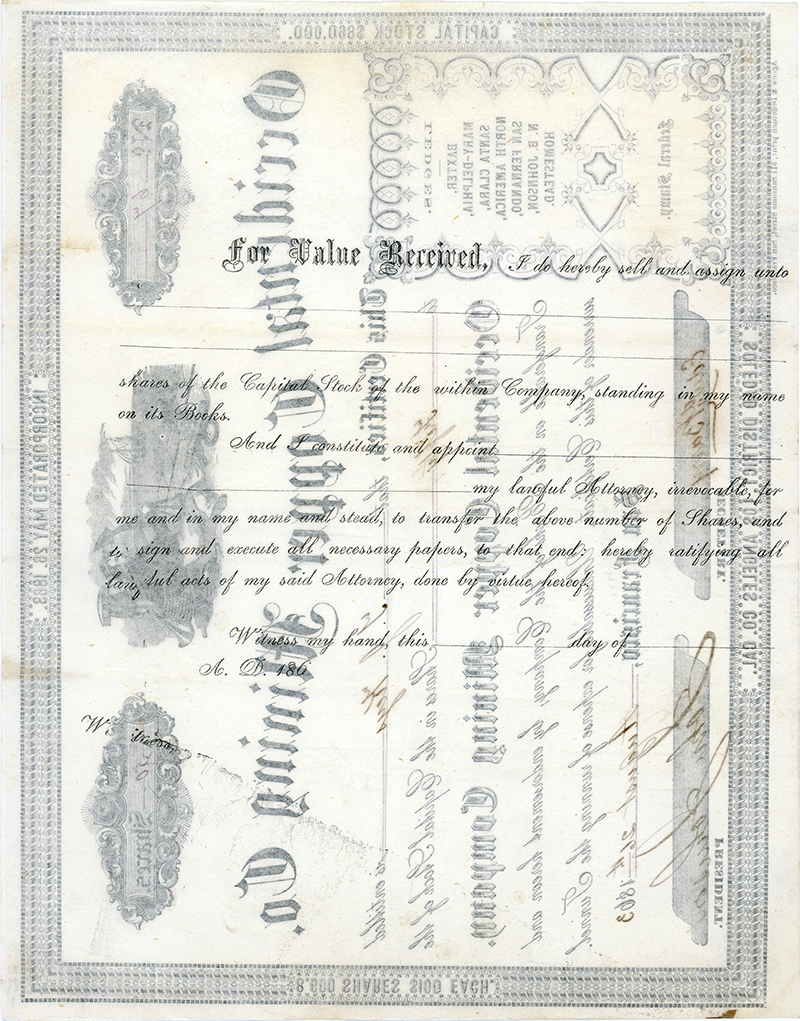|

Click to enlarge.
|
Occidental Copper Mining Co. stock certificate No. 67 for 50 shares ($5,000) issued at San Francisco to T.J.(?) Keys on August 26, 1863.
Ledges in the Soledad District, Los Angeles County, Calif.
Occidental issued 8,600 shares against a capitalization of $860,000.
This rare stock certificate[1] relates to mining activity in the "Soledad City" camps in Soledad Canyon that came to be known as Ravena City in 1868 and Ravenna in the 1870s.
Historians tend to think of gold in connection with the mines at Acton and Ravenna, but minerals
don't occur in isolation, and copper was the mineral that initially attracted miners to Soledad Canyon.
Perkins quotes journalist Ben C. Truman:
In 1861, attention was turned to the Soledad Canyon by the discovery of copper — a great excitement followed and nearly $300,000 was immediately sunk in development.
Some of the most beautiful specimens of native copper ever seen were found, many of which were in the formation of leaves, exquisitely frosted with silver.
The ore when found was incomparably rich and most of it contained 85 to 90 percent of metal. It was found only in chambers (pockets) however, there being no defined walls.
The stock certificate is 10¼x8 inches, translucent vellum or similar, printed by Agnew & Deffebach of Sansome Street in San Francisco. (Sansome was a major commercial street
with wharf access. Henry Newhall's contemporaneous auction house was on Sansome.) The certificate is signed by the company president, John Johnson,
and the secretary, Edward Barry. Barry was a mineralogist and John Johnson was listed as a merchant in the 1862 San Francisco Directory.[2] Barry
was also secretary of the Copper Hill Mining Co., which incorporated one year earlier and also operated in the Soledad District.
Mining certificates of the day usually identified the mining district where they operated — in this
case, Soledad — and sometimes also the ledges, or deposits, as this one does. The named ledges are the Baxter, Mary-Delphia, Santa Clara, North America, San Fernando, N.B. Johnson (named for one of the incorporators), and Homestead —
all of which were probably in the Acton-Ravenna area.
According to the Daily Alta California newspaper, in April 1863 a Mr. A. Woodside left by steamer,
presumably from San Francisco, with 20 miners to "run a tunnel through Galveston Hill for
the Occidental Copper Mining Company" and to develop claims for two other companies including Copper Hill Mining Co.
We don't know the location of Galveston Hill (could it be Mount Gleason?), but it was in the area. Per the Daily Alta California of April 12, 1963:
The tunnel through Galveston Hill will be run from both sides of the hill, meeting in the centre. The
length of the proposed tunnel is about twelve hundred feet, and will run through six well defined copper
leads, cutting some of them at a depth of four hundred feet from the surface.
The following month, on May 26, Occidental filed its incorporation papers. The incorporators were
N.B. Johnson, C. Learning, T. Young, William H. Codington, J.T. McLean, J.R. Richards
and John Johnson.
Historican Stan Walker suggests that "C. Learning" was actually
Christopher Leaming, an oil man who lived in the Newhall area (Petroleopolis, before it was Newhall)
from the 1860s until his death in 1888.
One notable curiosity in the Daily Alta California is that corporations raised capital by levying
assessments against shareholders. Occidental levied a 30-cents-per-share assessment in July 1863.
Delinquent payers had a sufficient number of shares sold at auction to cover their debt, the recordation being
made in the company's books.
(Note: There was an Occidental Copper Mining Co. that worked the Copper Creek Mine in Del Norte County in far-northern California. We don't know if it is related, but it seems doubtful.)
Further reading: A.B. Perkins: The Story of Our Valley, Part 5: Mining.
1. This is the only stock certificate from this company we've seen (besides the "other" Occidental up north).
It had been in the collection of Ken Prag, a major scripophily dealer
in the Bay Area (Burlingame, Calif.), and it came up for auction at least one other time in the early 2000s.
2. Per Holabird Americana, the auction house in Reno from which we obtained the stock certificate in 2019.
| 









